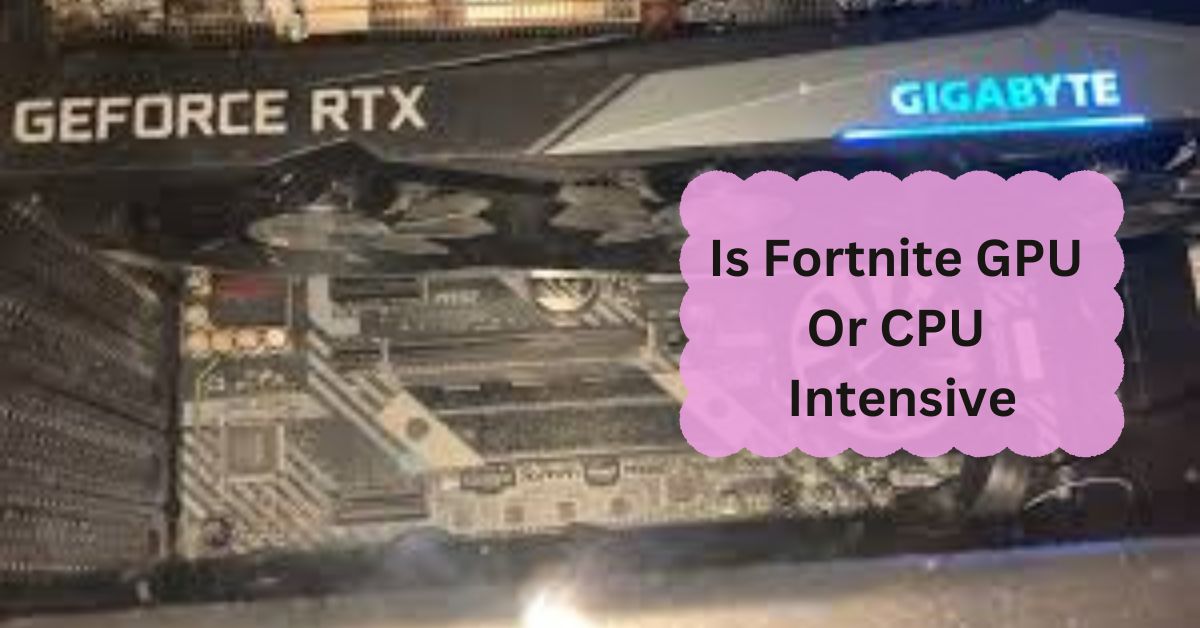Fortnite is one of the most popular games in the world, and many people wonder if they need a powerful GPU or CPU to play it well. “GPU-intensive” and “CPU-intensive” are terms used to explain which parts of the computer handle the most work in games.
Fortnite is more GPU-intensive than CPU-intensive, meaning it relies more on graphics power. However, a good CPU still helps smooth gameplay, especially in busy scenes. To run Fortnite well, a strong GPU is important, but a balanced CPU and GPU setup gives the best experience.
In this article, we will discuss “Is Fortnite GPU or CPU Intensive”.
Table of Contents
What Does GPU-Intensive Mean?
A game that is GPU-intensive uses the graphics processing unit (GPU) for most of its work. The GPU is also called a graphics card. Its main job is to handle images, effects, and visuals in games.
A GPU processes things like textures, shadows, lighting, and other visual effects. The higher the settings, the harder the GPU works.
If a game is GPU-intensive, it will need a strong GPU to run well, especially at high resolutions and with good visuals. In games like these, having a better GPU usually makes the game look better and play smoother.
What Does CPU-Intensive Mean?
A CPU-intensive game depends mostly on the central processing unit (CPU). The CPU is the brain of the computer, handling calculations, game logic, and instructions.
It’s responsible for tasks like controlling game physics, AI (computer-controlled characters), and loading game data.
In CPU-intensive games, the CPU is often under more pressure. If the CPU is not powerful enough, it might cause slower performance, especially when there are many players or complex actions on the screen.
Fortnite: Is It GPU or CPU Intensive?
So, is Fortnite more demanding on the GPU or CPU? Fortnite is a mix of both. This means it needs a good GPU for graphics and a decent CPU for other tasks.
Fortnite’s style is not as realistic as some other games, so it doesn’t need the most powerful GPU to look good. However, as a battle royale game, Fortnite has many players on one map, which puts some load on the CPU to manage all the data, players, and actions.
Fortnite relies on both the GPU and CPU. If you want smooth performance, you need a balanced setup with both a good GPU and a strong CPU.
How Fortnite Uses the GPU?
Fortnite has many visual settings that use the GPU. These include resolution, textures, shadows, and special effects. The GPU handles how the game looks. For example, high-resolution settings make the game look sharper, but this also requires more GPU power.
If you have a high-end GPU, you can turn up the graphics settings to see more details in Fortnite. However, if you have a mid-range or low-end GPU, you might need to lower some settings to keep the game running smoothly.
Changing settings like shadows and textures to medium or low can help boost performance without affecting gameplay too much.
How Fortnite Uses the CPU?
The CPU in Fortnite manages game logic, player movements, and background tasks. Since Fortnite is an online game, the CPU handles actions like managing multiple players, keeping track of buildings, and syncing player actions.
Settings like “View Distance” affect the CPU load. View Distance controls how far you can see other players or objects in the game.
A higher view distance means the CPU has to keep track of more things, which can be demanding. Reducing the view distance can lower the load on the CPU, which is helpful if you have an older or slower CPU.
Best Settings for Fortnite: Balancing GPU and CPU Performance
To get the best performance in Fortnite, you can adjust some settings to balance the GPU and CPU load. Here are a few tips:
- Resolution and Graphics Quality: Lowering the resolution or choosing a medium graphics setting reduces the work on the GPU. If you’re facing low FPS (frames per second), consider setting the resolution to 720p or lowering graphics quality.
- View Distance: Reducing the view distance can help reduce CPU load. Medium or even low view distance is good enough for most players and can help the game run faster.
- Shadows and Effects: Shadows and special effects make the game look nice but can slow it down. Turning shadows to low or off can improve FPS and reduce GPU load.
- Anti-Aliasing and Post-Processing: These settings help improve image quality but require extra GPU power. If you want more FPS, consider setting anti-aliasing to low or turning it off.
With these settings, Fortnite can run smoothly on many types of hardware, even on mid-range computers.
Do You Need a High-End GPU or CPU for Fortnite?
The good news is that Fortnite does not require the most powerful GPU or CPU. With the right settings, Fortnite can run well on mid-range or even budget hardware. Here are the minimum and recommended requirements:
- Minimum Requirements: Intel Core i3 CPU, Intel HD 4000 GPU, and 4GB RAM.
- Recommended Requirements: Intel Core i5 CPU, Nvidia GTX 660 or AMD Radeon HD 7870 GPU, and 8GB RAM.
If your system meets the recommended requirements, you can enjoy Fortnite at decent settings without any major issues.
How to Check Your GPU and CPU Performance in Fortnite?
To see if your GPU or CPU is causing any issues, you can check their usage. There are tools like MSI Afterburner or HWMonitor to track GPU and CPU usage. In Fortnite, you can also turn on the FPS (frames per second) display in the settings to see how smoothly the game is running.
If you notice low FPS or slow gameplay, check if the GPU or CPU is maxing out. If the GPU is at full load, try lowering graphics settings. If the CPU is at full load, try reducing settings like view distance to reduce the CPU demand.
Does Fortnite run on CPU or GPU?
Fortnite uses both CPU and GPU for optimal performance. The GPU handles graphics and rendering, while the CPU manages game logic and calculations. A balanced system with a strong CPU and GPU ensures smooth gameplay and better frame rates.
Does your CPU affect FPS in Fortnite?
Yes, your CPU does affect FPS in Fortnite. A powerful CPU helps in processing game data quickly, which can lead to higher frame rates. If the CPU is weak, it can bottleneck performance, causing lower FPS even if the GPU is strong.
Is Fortnite GPU Or CPU Intensive For Gaming?
Fortnite is more GPU-intensive than CPU-intensive. The game relies heavily on a strong GPU for smooth graphics, especially at higher settings. However, it still needs a decent CPU for stable performance, but a good graphics card will make the most difference.
Is Fortnite A GPU Based Game?
Yes, Fortnite is mostly a GPU-based game. This means it depends more on your graphics card for smooth visuals and gameplay. A good GPU will improve your experience, especially at high settings, though a decent CPU is still important for stability.
Is Valorant CPU Or GPU Intensive?
Valorant is more CPU-intensive than GPU-intensive. This means it relies more on your processor for smooth gameplay. While a good GPU can help, a strong CPU is more important for better performance, especially if you want high frame rates and fast response times.
Is Minecraft CPU or GPU-intensive?
Minecraft is more CPU-intensive than GPU-intensive. It relies heavily on the processor to load the world and manage game mechanics. While a good GPU helps for smoother visuals, a strong CPU is more important, especially when using mods or large worlds.
Is Roblox CPU or GPU-intensive?
Roblox is more CPU-intensive than GPU-intensive. It needs a good processor to handle game physics and other tasks, especially in complex games. While a decent GPU helps with visuals, a strong CPU will improve performance in most Roblox experiences.
Is Rocket League CPU Or GPU-intensive?
Rocket League is more GPU-intensive than CPU-intensive. It relies on the graphics card to deliver smooth visuals and gameplay, especially at higher settings. A decent CPU helps, but a good GPU is more important for the best performance and visual quality.
Fortnite Recommended System Requirements?
The recommended system requirements for Fortnite include a Core i5 or Ryzen 5 processor, a GTX 960 or Radeon R9 280 graphics card, 8GB of RAM, and Windows 10. These specs help the game run smoothly with good graphics and stable performance.
Fortnite CPU Intensive Settings?
In Fortnite, CPU-intensive settings include “View Distance” and “Shadows.” Higher view distance makes the game load more objects far away, which can strain the CPU. Shadows also use CPU power. Lowering these settings can improve performance on weaker CPUs.
Is Fortnite A CPU Or GPU Game?
Fortnite is more of a GPU game, meaning it depends on the graphics card for smooth visuals and gameplay. A good GPU improves performance, especially at high settings. However, a decent CPU is also needed for stable gameplay and fast response times.
Is Cod CPU Or GPU Intensive?
Call of Duty (COD) is both CPU and GPU intensive, but it leans more on the GPU for high-quality graphics and smooth gameplay. A strong CPU is still needed for faster load times and stable performance, especially in large multiplayer matches.
Is Cyberpunk CPU Or GPU Intensive?
Cyberpunk 2077 is more GPU-intensive, meaning it depends heavily on the graphics card for smooth visuals, especially at higher settings. However, a strong CPU is still needed for fast performance and to handle the game’s complex world and tasks without lag.
How much CPU is good for Fortnite?
A quad-core CPU with a speed of at least 3.0 GHz is recommended for Fortnite. Processors like the Intel Core i5 or AMD Ryzen 5 are good choices. More cores and higher speeds can improve performance, especially during intense gaming sessions.
Does high FPS use CPU or GPU?
High FPS relies on both CPU and GPU, but the GPU plays a more significant role. The GPU renders frames quickly, while the CPU ensures the game runs smoothly by handling tasks like physics and AI. Both components need to perform well for high FPS.
Is Fortnite GPU or CPU-intensive for gaming?
Fortnite is generally more GPU-intensive. However, it still requires a capable CPU to manage game mechanics and processes. A balanced system is crucial; a strong GPU enhances visuals, while a strong CPU maintains game flow and frame rates.
Is fortnite performance mode CPU or GPU intensive?
Fortnite’s performance mode is more CPU-intensive. It lowers the game’s graphics to improve performance, reducing the load on the GPU. However, it still relies on the CPU to handle faster gameplay, making it easier for lower-end systems to run the game smoothly.
Is Fortnite performance mode CPU-based?
Fortnite’s performance mode optimizes settings to improve FPS, reducing graphical detail to lessen the load on both CPU and GPU. While it can make the game more CPU-friendly, it primarily focuses on providing smoother gameplay overall.
Is Fortnite a GPU-based game?
Yes, Fortnite is primarily a GPU-based game. It relies heavily on the graphics card to render detailed visuals and effects. A good GPU will enhance the gaming experience by providing better graphics and smoother gameplay.
Is Valorant GPU or CPU intensive?
Valorant is more CPU-intensive compared to many other games. While a decent GPU is important for visuals, a strong CPU is crucial for maintaining high FPS and handling the game’s competitive mechanics, including hit registration and game calculations.
Is Roblox GPU or CPU intensive?
Roblox can be both CPU and GPU intensive, depending on the game being played. Simpler games may rely more on the CPU, while graphically intensive games require a better GPU. Overall, a balanced setup is recommended for the best experience.
Is Minecraft CPU or GPU intensive?
Minecraft is generally more CPU-intensive, especially with many mods or complex builds. However, a good GPU is still important for rendering the graphics smoothly, particularly when using high-resolution textures or shaders. A balanced system helps with performance.
Is Fortnite CPU or GPU heavy?
Fortnite is considered more GPU heavy due to its reliance on graphics rendering. However, a capable CPU is still necessary to manage game logic. A well-rounded setup with strong CPU and GPU support offers the best performance in Fortnite.
Why does Fortnite use 100% of my CPU and 30% of my GPU?
Fortnite may use 100% of your CPU if it’s struggling with processing tasks like game logic or running background applications. If the GPU usage is low, it could be that the game settings are too low, limiting graphical demand.
Is Rocket League CPU or GPU intensive?
Rocket League is more GPU intensive, focusing on rendering graphics and effects during fast-paced gameplay. However, a good CPU is still needed to handle game mechanics, like physics and player controls, for a smooth experience.
Is Fortnite CPU-intensive?
Yes, Fortnite can be CPU-intensive, especially in battles with many players and complex environments. A strong CPU is necessary to handle game logic and calculations, ensuring that performance remains smooth and stable during gameplay.
Is streaming Fortnite more CPU-based or more GPU-based?
Streaming Fortnite is more CPU-based. The CPU manages the game and the streaming software simultaneously. A good GPU is still important for rendering the game smoothly, but the CPU’s performance significantly impacts streaming quality.
Why does the CPU stay at 100 percent while playing Fortnite?
A CPU at 100% usage during Fortnite can indicate that it is struggling to process game data efficiently. This may happen due to background applications, inadequate CPU power, or game settings that demand more resources than the CPU can provide.
FAQs:
1. Do I need a strong GPU to play Fortnite?
Not necessarily. Fortnite can run on mid-range GPUs, but having a better GPU helps if you want higher graphics settings and smoother visuals. Lowering graphics settings can help if your GPU is not very powerful.
2. Is Fortnite more CPU-intensive or GPU-intensive?
Fortnite is a balanced game; it needs both GPU and CPU power. The GPU handles graphics, while the CPU manages game logic and multiplayer actions. For the best experience, both parts should be decent.
3. What are the minimum requirements to play Fortnite?
You need an Intel Core i3 CPU, Intel HD 4000 GPU, and 4GB of RAM for the minimum settings. This will let you play, but you may need to lower graphics settings for smoother performance.
4. How can I make Fortnite run faster on a low-end PC?
Lowering graphics settings like resolution, shadows, and view distance can help. Setting these to medium or low reduces the load on both the GPU and CPU, helping the game run more smoothly.
5. Can I play Fortnite without a dedicated graphics card?
Yes, Fortnite can run on integrated graphics like Intel HD, but the performance will be limited. You may need to use the lowest settings for a playable experience.
6. Does Fortnite use more CPU power in multiplayer mode?
Yes, multiplayer mode puts more pressure on the CPU because it has to keep track of other players and game actions. Reducing settings like view distance can help reduce CPU load.
7. Which graphics settings affect the GPU the most in Fortnite?
Resolution, shadows, and effects use the most GPU power. Lowering these settings can improve FPS and reduce the load on your GPU.
8. How can I check if my CPU or GPU is causing slow performance in Fortnite?
You can use tools like MSI Afterburner or HWMonitor to monitor CPU and GPU usage. If the CPU or GPU shows high usage (near 100%), it might be causing slow performance.
9. Will lowering the resolution help my GPU?
Yes, lowering the resolution reduces the GPU load and can improve FPS. Lower resolutions require less power, making it easier for your GPU to run the game smoothly.
10. What’s the recommended hardware for playing Fortnite smoothly?
For a good experience, Fortnite recommends an Intel Core i5 CPU, Nvidia GTX 660 or AMD Radeon HD 7870 GPU, and 8GB of RAM. This setup should handle medium to high settings.
Conclusion:
In conclusion, Fortnite is a game that uses both GPU and CPU power for the best performance. A good GPU improves graphics, while a strong CPU helps with game logic. Players can enjoy Fortnite on mid-range hardware by adjusting settings. Balancing both components is key to a smooth and enjoyable gaming experience.


